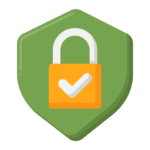▷ See all step-by-step guides.
Find out in 7 steps how to take an integration course. A quick overview:
- Search for a school. Contact the school by email, phone or in person.
- Register directly with a certificate of eligibility.
- The school or you can apply for admission if necessary.
Click on headlines to open steps
- For more information, click on the small numbers.1Example
1. Is an integration course right for you?

2. Can you take an integration course?

- If you have applied for asylum in Germany, you are generally permitted to take an integration course.3This does not apply to people from the following “safe countries of origin”: Albania, Bosnia & Herzegovina, Georgia, Ghana, Kosovo, North Macedonia, Montenegro, Republic of Moldova, Senegal and Serbia If places are available, you can already attend the course during your asylum procedure. The sooner you register, the sooner you can start.
- In some cases, you can also take an integration course with a Duldung (tolerated stay permit).4With a Ermessensduldung/ discretionary tolerated stay permit (§60a AufenthG), Ausbildungsduldung/tolerated stay for the purpose of vocational training (§60c AufenthG) or a Beschäftigungsduldung/ tolerated stay permit for work (§60d AufenthG)
- If you have received a certificate of eligibility (Berechtigungsschein) for an integration course with your residence permit (e.g. as a skilled worker), you can directly register with a school.
- If you do not have a certificate of eligibility, you can apply for admission.5See step 5. Further information can be found at Handbook Germany.
3. Is an integration course free of charge for you?

- The course is usually free if you are not working or have a low income.6If you receive asylum seeker benefits, Bürgergeld (“Citizen’s Allowance”), unemployment benefits (Arbeitslosengeld I) or social assistance (Sozialhilfe) or your gross monthly salary is less than €2,491 (without child), €3,246 (one child), €4,001 (two or more children), the course is free for you.
- If the course is not free for you, you will have to pay around 1,600 €. You may be able to get 50% of the costs back later.7For that, you have to pass the final exam within 3 years and submit an application.
4. Search for a school

- Search for a school in your area that offers integration courses.8You can use Google, the search function of the BAMF or the employment agency, for example
- Contact the schools via email, phone, or in person and ask if there will be places available soon. If you need help finding a school, contact a local counseling center.
5. Submit an application to the BAMF

- If you have found a school, the school will assist you with the application. The response can take 1-3 months.
- If you have not found a school, it makes sense to submit an application yourself not to loose time. You do that by sending an application by letter to BAMF. If you have applied for asylum, have a Duldung (tolerated stay permit) or a Aufenthaltserlaubnis (residence permit) under §24 or §25, fill out this form. If this does not apply to you, use this form.9If you have a residence permit with an online function, you can submit the application online.
6. Maybe apply for money for your travel expenses

- If you have no income10The regulation applies to everyone who receives asylum seeker benefits, Bürgergeld (“Citizen’s Allowance”) or social assistance (Sozialhilfe). and the distance to your course is more than 3 kilometers, you can apply for a contribution to your travel costs.
- Your language school or you must submit an application for this. Attention, the application must be submitted before the start of the course.11This form must be sent to the BAMF.
7. Start your integration course

- Once BAMF has approved your applications, you can start your integration course.12 Once you have registered, you have one year to complete the course. After that, the certificate of eligibility (Berechtigungsschein) is no longer valid.
- If your application is rejected, you can look for other options to learn German.13You can ask for help at a local counseling center. If necessary, ask for help at a local counseling center.
This page was realized with the support of the Postcode Lottery. (Last updated August 2024)
▷ View all step-by-step guides.
▷ Get in touch with us.
Fußnoten
- 1Example
- 2You can find more information here.
- 3This does not apply to people from the following “safe countries of origin”: Albania, Bosnia & Herzegovina, Georgia, Ghana, Kosovo, North Macedonia, Montenegro, Republic of Moldova, Senegal and Serbia
- 4With a Ermessensduldung/ discretionary tolerated stay permit (§60a AufenthG), Ausbildungsduldung/tolerated stay for the purpose of vocational training (§60c AufenthG) or a Beschäftigungsduldung/ tolerated stay permit for work (§60d AufenthG)
- 5See step 5. Further information can be found at Handbook Germany.
- 6If you receive asylum seeker benefits, Bürgergeld (“Citizen’s Allowance”), unemployment benefits (Arbeitslosengeld I) or social assistance (Sozialhilfe) or your gross monthly salary is less than €2,491 (without child), €3,246 (one child), €4,001 (two or more children), the course is free for you.
- 7For that, you have to pass the final exam within 3 years and submit an application.
- 8You can use Google, the search function of the BAMF or the employment agency, for example
- 9If you have a residence permit with an online function, you can submit the application online.
- 10The regulation applies to everyone who receives asylum seeker benefits, Bürgergeld (“Citizen’s Allowance”) or social assistance (Sozialhilfe).
- 11This form must be sent to the BAMF.
- 12Once you have registered, you have one year to complete the course. After that, the certificate of eligibility (Berechtigungsschein) is no longer valid.
- 13You can ask for help at a local counseling center.